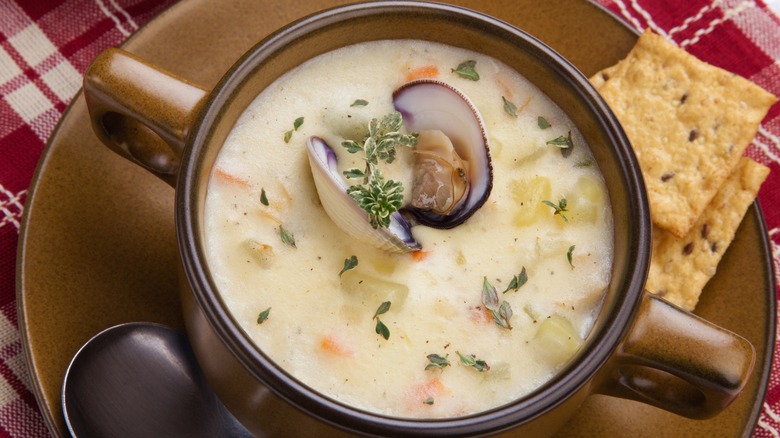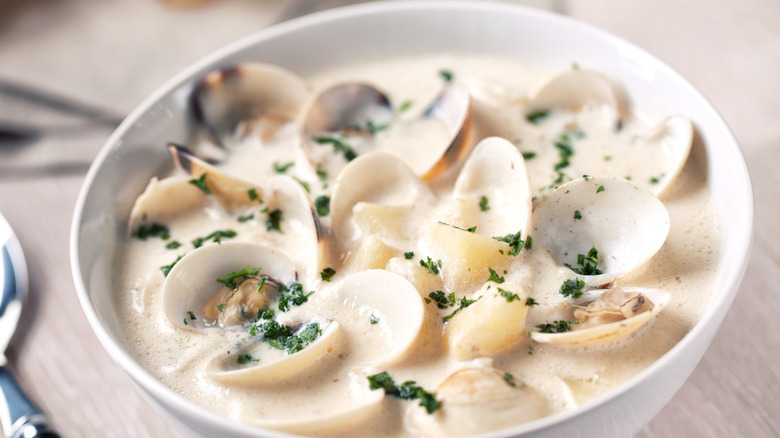Add Some Vermouth To Your Clam Chowder And Thank Us Later
The difference between a good clam chowder and a great one can be as simple as a splash of vermouth. Even though the liquid might be a key ingredient in a well-shaken cocktail, it can also be a flavor boost to a better clam chowder.
While martini drinkers might have a well-used bottle of vermouth behind the bar, others might be unfamiliar with the fortified wine's flavor. Available in both white and red varieties, the straw-colored white version highlights a dry, slightly floral flavor. Red vermouth tends to be sweeter, slightly spicy, with an herbaceous quality. The two varieties are not interchangeable.
For the traditional clam chowder, the base of potatoes, mirepoix, bacon, and briny clams can benefit from the floral, dry white vermouth. The vermouth can cut through the denseness of the potatoes and the unctuous notes of the bacon. Since this fortified wine tends to be less acidic than some white wines, it will not overshadow the saltiness of the clams. Overall, the white vermouth lifts the taste by bringing an additional, subtle flavor profile to ensure balance in the dish. From keeping the chowder from being too heavy to avoiding a one-note spoonful, vermouth can be the secret ingredient that makes for a more enjoyable, comforting bowl of clam chowder.
When should vermouth be added to clam chowder?
While vermouth might be the secret ingredient to a better clam chowder, it should be added at the right time. Unlike a drizzle of sherry poured into a lobster bisque right before serving, vermouth needs the alcohol to be cooked out. Raw wine flavor is not very palatable. Generally, the vermouth is added after the mirepoix or other vegetables are sweated in the pan. The dry, white vermouth can help to deglaze the pan and release all the flavors from the cooked vegetables. In addition, the heat burns off the alcohol. While it might not show a blue flame, the heat releases the alcohol but leaves the floral, fortified wine flavor.
In some cases, cooks might add the vermouth with the clam juice and other liquids. While that option is a possibility, the low, slow simmer can take longer for the alcohol to cook out. It is another cooking technique, but it requires more care during the process. Still, the end result of a more balanced chowder can be achieved.
Should that old, dusty bottle of vermouth be used in cooking?
While some spirits and wines on the bar are opened and used quickly, other bottles rarely come out from the back shelf. Unlike wine or whiskey, age does not typically make vermouth better. Generally, an unopened bottle of vermouth can last about three to four years. The bottle should be stored away from direct skylight and away from heat. With opened vermouth bottles, the fortified wine should be used one to two months after being opened. If the bottle seems like it has been around too long, it has.
More importantly, an old bottle of vermouth offers other indications that it has gone bad. Putting aside the dust on the bottle, the aroma should not be rancid. Any sour taste is a clear indication that the bottle should go down the drain and not in the pot. If vermouth is not a common ingredient used behind the bar or in the kitchen, it might be best to opt for a small bottle. Some people might cry over spilled milk, but wasting money by dumping a vermouth bottle down the drain could cause a few tears, too.


